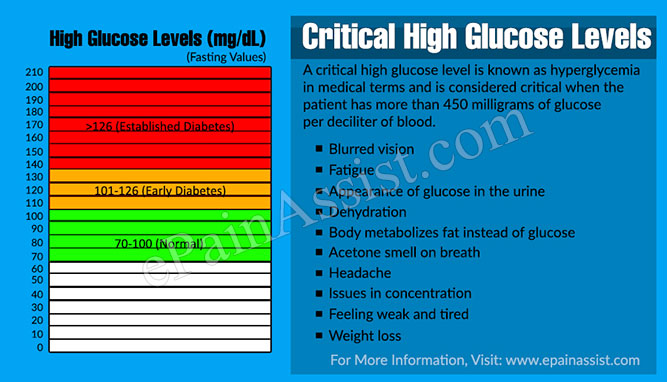One of the major goals of diabetic patients is to keep their glucose levels well within the normal to prevent various complications. Apart from the commonly known diabetic complications, the basic thing is critical low glucose and high glucose levels. Such extreme levels, be it low or high, can cause extensive damage to major organs and nerves in the human body and even prove fatal in severe cases.
This is why diabetic patients should work in sync with their dietician, physical trainer and doctor to ensure that they remain healthy and prevent their glucose levels from fluctuating.
Critical Low Glucose and High Glucose Levels
In most cases, diabetes is diagnosed by a blood test wherein the sugar level in the blood is determined. In some cases, it is the symptoms of critical low glucose and high glucose levels that compel patients to seek their physician’s help. Such critical levels of glucose are more likely to occur in type 2 diabetes as compared to type 2 diabetes. While symptoms give a fair idea of the possible extreme blood sugar levels, blood tests are essential to confirm the diagnosis. They also help to plan appropriate treatment and diet regimen.
It is important to know that with proper care, healthy diet, regular physical exercise and routine check-ups, your blood glucose level will never reach a critical level.
Preventing such extreme is essential, however, in case, they occur, you should be able to identify the symptoms and seek immediate medical attention. Hence, it is important to know about critical low glucose and high glucose levels.

Critical Low Glucose Levels
Critical low glucose levels are known as hypoglycemia in medical terms and is considered critical when the patient has 40 milligrams of glucose per deciliter of blood or below that. However, researchers’ state that this figure may vary from one person to another because the level at which these symptoms develop also differs in people.
Hypoglycemia can also develop under specific conditions when the patient takes insulin and other types of medications for diabetes. For example if a patient skips a meal but takes his insulin dose as usual it can lead to hypoglycemia in the long run. Also errors in medications and drug interactions in patients of type 2 diabetes often results in hypoglycemia.
Some of the commonest symptoms of hypoglycemia are mentioned below. It is important to note that these symptoms occur suddenly and may aggravate rapidly.
- Anxiety and/or nervousness
- Shakiness
- Chills and sweat
- Impatient or irritability without reason
- Confusion
- Dizziness or light-headedness
- Heartbeat becomes fast
- Sleepiness
- Excessive hunger
- Blurred vision
- Numbness or tingling in the tongue and lips
- Fatigue and weakness
- Headache
- No coordination
- Anger and stubbornness
- Seizures
- Unconsciousness
- Nightmares
When you experience any of these symptoms of critical low glucose levels as a diabetic patient, you should immediately consume 15 to 20 grams of simple carbohydrates or glucose such as glucose tablets, raisins, fruit juice, regular soda, sugar or honey or hard candies. Check glucose level after 15 minutes to ensure it has normalized or take another dose of glucose or simple carbohydrates.
Most patients are not aware of the fact that critical low glucose levels can also lead to seizures and coma and prove fatal for some.

Critical High Glucose Levels
A critical high glucose level is known as hyperglycemia in medical terms and is considered critical when the patient has more than 450 milligrams of glucose per deciliter of blood. Some of the classic symptoms of hyperglycemia are frequent urination and increased thirst which is a clear indication that the patient’s blood glucose levels have risen above normal.
The most common reasons for developing hyperglycemia is eating too many calories, having an infection or illness, missing medicines, surgery, injury or emotional stress which can cause your glucose level to rise unconditionally. Also, if you miss a dose of insulin, it causes the glucose levels to rise rapidly. If your glucose level stays very high for several weeks in a row, your body starts adjusting to that increased level thereby preventing any symptoms of high blood sugar levels. However, this does not mean that your blood glucose level has become normal in any case.
Other common symptoms of hyperglycemia or critical high glucose levels which develop slowly over time are:
- Blurred vision
- Fatigue
- Appearance of glucose in the urine
- Dehydration
- Body metabolizes fat instead of glucose
- Acetone smell on breath
- Headache
- Issues in concentration
- Feeling weak and tired
- Weight loss
Critical high glucose levels can damage major body organs such as heart, kidneys, blood vessels, eyes and nerves and is best prevented from the very beginning. Diabetic patients need to monitor their high blood glucose levels regularly and also keep a check on the symptoms. With this, chances are that you will be able to treat this critical level easily and prevent complications from arising.
The best ways to prevent critical high glucose levels from occurring include
- Testing your blood sugar from time to time.
- Calling your doctor as soon as your blood sugar increases more than normal to adjust medications and dosage.
- Drinking loads of water every day, avoiding sugary and caffeinated drinks and saying no to alcohol and smoking.
Conclusion
Critical low glucose and high glucose levels, both can be quite dangerous for your body; even fatal in some cases. Keeping your blood glucose level in check is absolutely mandatory to prevent high and low blood glucose levels.
Make sure you eat healthy every day and make necessary lifestyle changes to stay healthy. Also regular physical activity is the key to keep your glucose level in check. Do not forget to test your blood sugar levels regularly and consult your doctor in case of any fluctuations.
